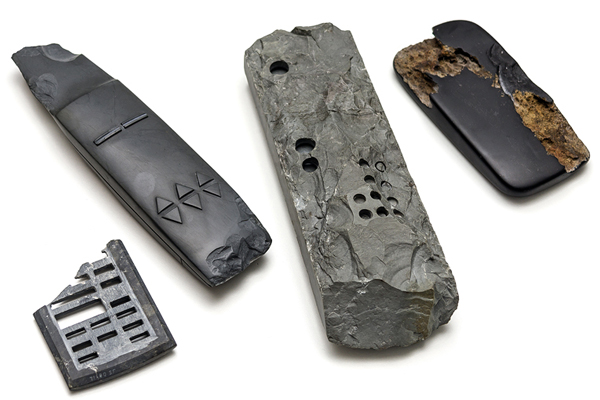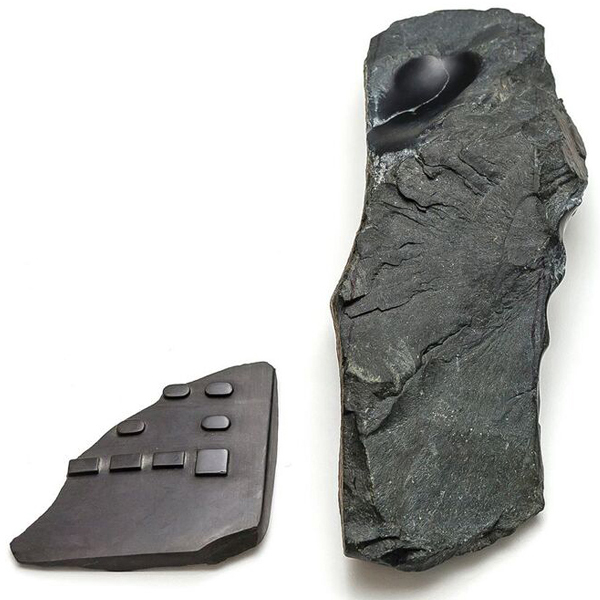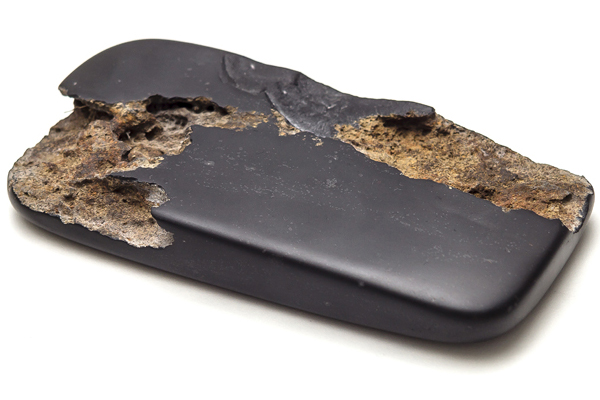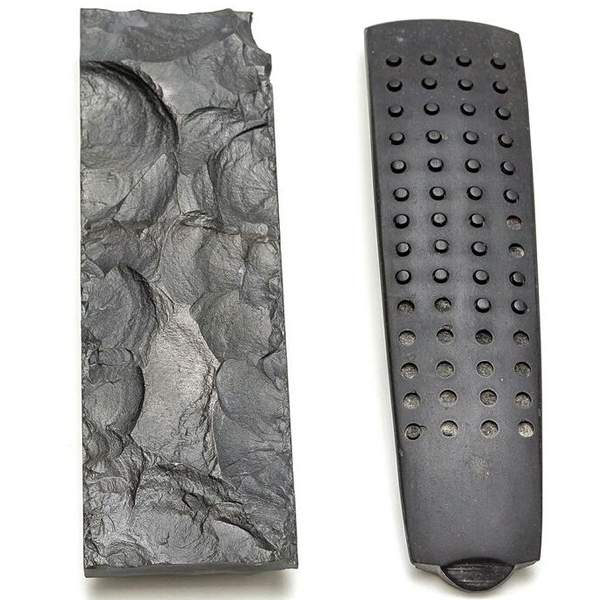Susan Cummins: Why is the collection of objects you made for your show at Velvet da Vinci called The Quick and the Dead? Does it have anything to do with the Louis L’Amour American western book, or the movie of the same name?
Joe Sheehan: Yes and no. To be honest, I haven’t read the book. I saw the movie once when I was a kid but I can’t really remember it, so I’m not referencing the film specifically.
I liked the irony of the “quickdraw” reference in relation to the TV remote, but mostly I’m borrowing LLA’s double meaning of “quick”: the idea of speed as it relates to time, and the relationship between the living and the dead, present and past.

These stone carvings resemble remote controls and modern electronic equipment. Why are you carving remote controls in stone?
Joe Sheehan: A few years ago I saw an eBay listing of over 700 TV remotes. I used to search simply for “lot” or “collection” because I always thought it was interesting to see what people get into, what and how they curate elements of their lives.
The collection of TV remotes hit me straight away. The amount on display seemed staggering, and the way that they were arranged in the photographs really caught my eye. The seller seemed to have put a lot of thought into the way they were grouped, and to me they looked very similar to collections of stone adzes I had seen here in books and museums.
They were a similar size and color, similar shapes, were both examples of a technology that had become ubiquitous, but they existed at extreme ends of a timeline of use and redundancy.
So I began playing around with the idea of making these points meet and overlap by carving pieces that were both and neither, that didn’t look like they belonged to any fixed point in time and so could shift around a bit. I wanted to see if there was any relationship there other than the one in my head, and I was interested most in the possibility of upsetting the viewer’s perspective in the same way mine had been upset. That is, so that instead of looking into the cabinet and seeing these things as only belonging to some “other,” they might also recognize themselves in the objects.

Is stone carving a New Zealand tradition?
Joe Sheehan: It’s not really a tradition although it comes from one of the greatest. Maori culture has produced some of the finest examples of stone carving and material technology found anywhere on the planet, so we are lucky to have this to draw from. Traditional Maori carving almost died during the process of colonization, and it’s only in the last century that stone carving has seen any kind of renaissance. Carving in NZ now happens at all sorts of levels from the hobbyist to the tourist carving of fish hooks and Tiki, but also through this resurgence of interest a space opened up for a more contemporary approach. Both Craig McIntosh and I operate within this space, which draws its influences from not just Maori tradition but contemporary jewelry and other modern art movements.
Do your carved objects relate to Maori carvings? If so, how?
Joe Sheehan: As I have said, if you are carving stone in NZ, you are engaged with Maori culture or history in one way or another. It is the fulcrum point, and in my work provides an opportunity to gain leverage in relation to ideas of place and identity and to work against the overly simple notion that cultural relationships are bound to an us-and-them dynamic. Good artwork should operate like a big mirror, so that the viewers can see not only themselves, but those around and behind.
When did you decide to become a carver and where did you learn?
Joe Sheehan: My father was a jade carver and I learned how to carve from him. I grew up around stone and carving machines and spent many hours in the workshop watching his hands and then making my own small shapes from the age of about 11 or 12. After school I studied contemporary jewelry in Auckland and then spent a few years working as an in-store carver in a tourist jade shop in Rotorua. During that time I traveled a lot, many of the trips taking me to jade mines around the world. Eventually I needed to get out and do my own thing. I had become wary of the limits within such a commercial environment. I set up a workshop in Wellington and had my first show, Limelight, in 2004 at Objectspace in Auckland. Since then I have been exhibiting each year and ranging in scale and materials.

What do you enjoy the most about carving? What sort of tools do you use?
Joe Sheehan: The reductive nature of carving is a process of collaboration with your material that you don’t find in other art disciplines as much. Stone is so resistant and there is something deeply rewarding in the negotiation required to get to where you want, not that it is just hard work, more that the uniqueness of the material means that the outcome is often surprising. The tools I use are all pretty straightforward—saws, grinders, and drills, all diamond-tipped. In fact, these are the same types of machines that the Chinese were using 4,000 years ago with the addition of electric motors. The way they are employed is different, though, I guess. There is a sort of traditional method of carving here that has developed out of a desire to replicate Maori adornment and tools for the tourist industry, but my approach isn’t bound by that so I end up doing things differently. For instance, the The Quick and the Dead series involved me making and finishing the works as whole pieces and then smashing them apart with a hammer. It wasn’t until they had this energy of destruction that they made any real sense to me.
You are making objects but showing them in a jewelry environment. Why?
Joe Sheehan: So much of what makes stone carving in NZ unique is its relationship to Maori adornment and artifacts, so for both Craig McIntosh and I, these things make sense in a room together. We come from a carving background, have similar influences, and work with similar materials, but have ended up in very different places. Craig’s work is jewelry and mine is sculpture scaled around artifacts, so we thought it would be interesting to present these two different but complementary approaches to stone carving in one exhibition.
Who do you look to for inspiration?
Joe Sheehan: There are so many. Locally, Warwick Freeman always has something to hook my eye, and I have always been a huge fan of Christian Marclay.
What have you seen, heard, or read recently that you could recommend?
Joe Sheehan: Seen: Hennessy Youngman, for essential art commentary you can watch with your kids.
Read: Calvino’s Cosmicomics, for when you want to feel the normality and profundity of absurdity.
Heard: The sublime soul of The Montgomery Express. Their The Montgomery Movement album is one of the most incredible things I have ever heard.
Thank you.





